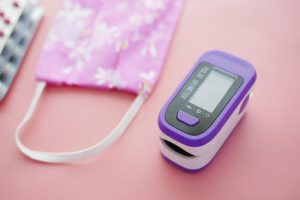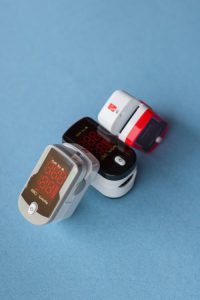Table of Contents
Manifestation of Neurosis using Pulse Oximeters?
Against the background of the ongoing coronavirus pandemic, we can talk about another “pandemic” – an increase in the number of mental disorders and Neurosis.
Among the most common are various forms of neurosis, neurotic disorders with a focus on health conditions
Today we will figure out in which cases the observation of the body’s indicators has a psychological background.
At first glance, the desire to track health indicators looks completely normal. But from a psychologist’s point of view, the use of medical devices can be caused by conditions that have nothing to do with prevention.
Total control or the first signs of Neurosis?
The use of home medical devices can be perfectly justified. For example, during treatment, the doctor may recommend monitoring indicators of interest to him, for example, blood pressure.
In this case, the patient will be asked to take measurements in certain situations or at a given frequency.
This is necessary to assess the effectiveness of the prescribed therapy, and this assessment will be carried out by the doctor himself.
It’s another matter if a person decides to take on his health himself, tries to control everything and does it, relying only on his own feelings.
The use of devices to measure health indicators often indicates the appearance of an anxiety disorder.

The leading positions here are occupied by pulse oximeters monitors and heart rate monitors – devices for measuring blood pressure and heart rate.
Blood Pressure Monitor and Heart Rate Monitor at Home as a Manifestation of Anxious Patient
What are Signs of a Neurosis Person?
A person carries a tonometer with him and uses it every 30 minutes.
An anxious patient is afraid that the rise in blood pressure will kill him, and he has a ritual, we call it a compulsion, supposedly of checking blood pressure and monitoring health.
In the same way, people monitor their heart rate, constantly correlating their indicators with the norm.
During the coronavirus pandemic, another one was added to these popular devices – a pulse oximeter, it also measures the pulse rate, but most importantly, the level of oxygen saturation (saturation) of the blood, which has become especially important in the diagnosis of COVID-19.
At the same time, it is important to understand that these devices themselves are not the source of the problem, they are a manifestation of the problem.
That is, a person fears for his heart, fears for his health, he has hypochondria, panic disorder, and thus he tries to control all this. This is a way of sublimating hype control in an anxious patient.

Anxiety is often accompanied by increased heart rate, increased blood pressure and other symptoms.
This is typical for anyone who experiences fear or intense anxiety. But a person in a state of anxiety disorder begins to track their indicators, fearing that they will miss a heart attack or stroke.
Anxiety states create functional reversible disorders of the body. This applies to tachycardia, episodic rise in blood pressure, gastrointestinal disorders (diarrhea, constipation), feeling of incomplete inhalation or breathing discomfort, chills or fever.
Anxiety disorders do not destroy the body or create disease, but create dysfunction that is completely reversible and its reversibility is an emotional state.
There are also people who react to emotional disorders with a slight increase in temperature in the range of 37-37.2
Way out of the vicious circle
Experts divide the therapy of such patients into several stages. First, this is an explanation that an increase in heart rate and a rise in blood pressure, caused precisely by anxiety, and not by disease, do not pose an immediate threat.
The second stage is the gradual nullification of the use of the device (tonometer, heart rate monitor, or others).
Well, for example, a person is first allowed to measure blood pressure once in the morning, once in the afternoon and once in the evening.
A little later – once in the morning and once in the evening. Then only in the morning, then only in the evening, and in the end we do not measure blood pressure at all.
Thus, a person gradually realizes that the lack of control over the pulse and blood pressure should not be considered a problem.
It seems to patients that their main problem is heart and pressure, but in reality these are relationships in personal or professional spheres, these are some kind of uncommitted decisions, unlived feelings, resentments and emotions.
This is where all the anxious neuroses lie. And their purely functional manifestations are just physiology.
Unhealthy neurosis
You can use a little analysis to determine which relationship connects you to a pulse oximeter monitor or thermometer.
For example, during a coronavirus pandemic, it is natural to wash your hands more often and more thoroughly than usual.
This is anxiety-related, but situational. But the problem arises when we start washing our hands with some strange chemical solutions, burning the skin.

It is also important how often certain procedures are repeated.
If we continue the parallel with washing hands, then it’s one thing if a person washed his hands once and forgot.
Another thing is a person with obsessive-compulsive disorder. He will wash his hands once, but it seems to him that this is not enough, he washes them again, then again. And this criterion “not well washed hands” is a symptom of anxiety disorder, which is not situationally determined.
In order to prevent the development of neurosis in oneself, it is necessary to exclude stressful situations and emotional reboots. Take breaks from work when doing hard mental work.
Do something that is enjoyable and relaxing or calming. Also, for prevention, meditations are suitable, which completely relax the body and mind and lift the mood.
And do not forget, if you feel constant panic attacks, a decline in emotional state or other alarming symptoms of neurosis, consult a specialist.
